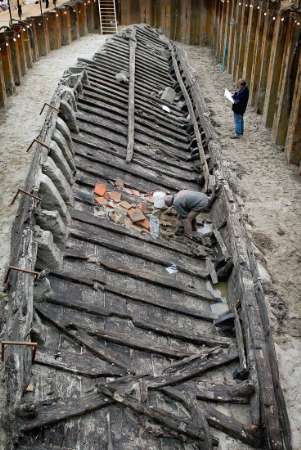








|
|
Dutch Cargo Ship Find Gives Clue to Roman Defense
October 27th, 2003
By Lucas van Grinsven
WOERDEN, Netherlands (Reuters) - Dutch archaeologists have discovered a Roman cargo ship equipped with oars, a unique find that explains how imperial Rome defended itself on its Northern frontiers, they said Tuesday.
The barge, dating from around 100 AD, was excavated in the Dutch town of Woerden which was once the location of the Roman military settlement Castellum Laurium on the banks of the Rhine.
The flat-bottomed boat was manned by at least 12 rowers. The oars would have allowed the Romans to navigate strong currents back to the German Eiffel region from where it had brought rocks to strengthen the forts along the frontier.
Until now, archaeologists and historians had thought the Romans could only sail downstream with their cargo vessels, which resemble today's bulky barges.
Exactly 100 Roman feet (about 100 feet) long, the ship would be dismantled and the wood used as building material together with its cargo, according to this theory.
"This is the first time we have evidence that these barges could sail back upstream," archaeologist Wouter Vos said.
The cargo vessels, some 30 of which have been discovered in northwest Europe, date back to an era when the Romans were improving their fortifications along the Northern borders of their empire.
The marshy estuary of the Rhine contained no rocks to replace the limestone walls and towers, so these had to be imported from Germany by boat. Each of the 15 to 20 Roman forts along the Dutch Rhine were run by some 500 mercenary troops from elsewhere in the empire, overseen by a 5,000 strong Roman legion in Nijmegen.

Photo Reuters

|